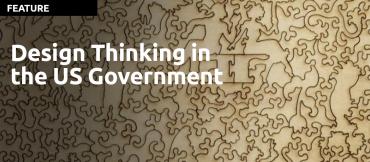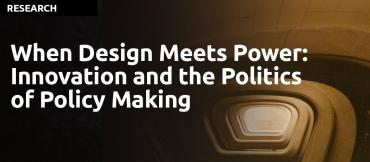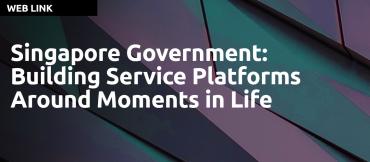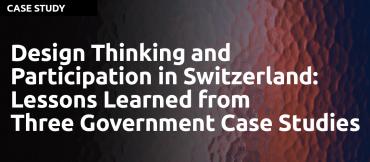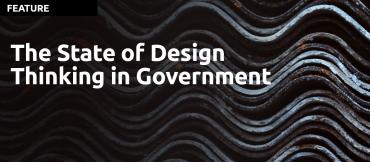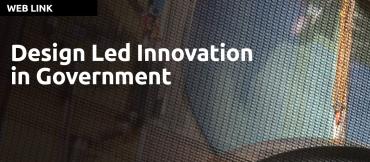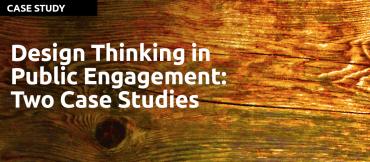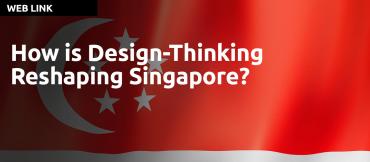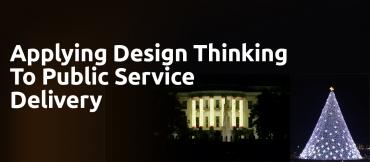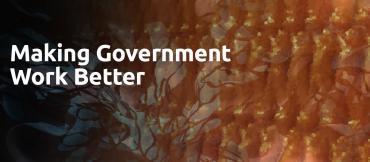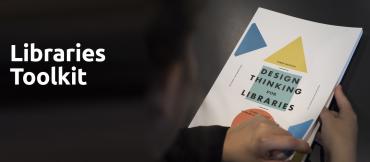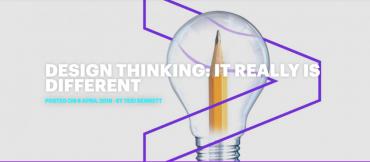
The type of problems that governments face are by nature, complex, undefined, huge in scope and potential impact and primarily targeted towards helping people live better lives. These are the types of human centered problems that Design Thinking is ideally suited to solve. Design Thinking has been successfully deployed in many government departments around the world, such as the Aarhus Public Library (Denmark), the City of Calgary, the Australian Taxation Office, The White House (Office of Science and Technology), DenMark's Municipality of Holstebro, The Office of Personnel Management (OPM) of the US Federal Government and the Government of Singapore. Read case studies on design thinking in the work of government as well as other thought leadership articles about the use of design thinking's impact in government projects on this page.
You might also be interested in the case studies in the Non-Profit/Social Good section.
Design thinking, a problem-solving approach that emphasizes empathy, experimentation, and collaboration, has gained significant traction in various sectors, including business, education, and healthcare. In recent years, the US government has also recognized the potential of design thinking to drive innovation and address complex challenges. By adopting design thinking principles, government agencies have been able to enhance citizen-centric services, streamline processes, and deliver impactful outcomes.
Responding to the need for innovation, governments have begun experimenting with ‘design thinking’ approaches to reframe policy issues and generate and test new policy solutions.
This paper examines what is new about design thinking and compares this to rational and participatory approaches to policymaking, highlighting the difference between their logics, foundations and the basis on which they ‘speak truth to power’.
In 2022 India became the first country to offer Design Thinking as an option at K9-12 high schools. Design can be difficult to introduce in schools as it diverges from traditional classroom concepts. The evaluation process involves studying the learning process, portfolios or exhibits created by the student rather than exams. Each learner would produce a unique portfolio as an outcome whereas traditional education generates identical answers.
In this use case the cities of Aalborg and Rotterdam share their findings obtained from design thinking initiatives. This is based on empirical research as part of an evaluation. The use case is written for other professionals in the field of design in public organizations.
This case study focuses on a Design Thinking Workshop for primary school learners. The aim of the workshops was to provide learners with a new set of skills which they can employ when problem solving for real world challenges.
Building resilience is essential for cities that face increasing uncertainty and new challenges that threaten the well-being of its citizens. This is especially important when looking at the diversity and complexity of potential shocks and stresses.
A recent reorganization at King County Metro had resulted in a new market innovation division, charged with expanding network reach and transportation options through employer partnerships, direct community engagement, and increased mobility and accessibility offerings. With an ambitious new charter and a number of new team members, it was important to set a collaborative tone and to get everyone working quickly and embracing iteration to fuel breakthrough innovation.
A key priority was to get the new team thinking about how it could better meet the needs of its customers.
In 2017, the product development team at Singapore’s Government Technology Agency (GovTech) was tasked to develop a tool to consolidate citizen-facing services previously delivered by different government agencies onto a single platform. The initiative, Moments of Life, sought to make it easier for citizens to discover and access relevant services during important changes in their lives by reducing fragmentation and being more anticipatory in the delivery of those services.
The UK government fully appreciates the role of design as a driver of economic growth...Design is a source of competitive advantage and can help organizations transform their performance. That is why design forms an integral part of the Government’s plans for innovation and growth.
This is an incredible set of guiding principles for government services design for anyone involved in government work anywhere in the world. Does your government have a set of published guidelines on how to design services? If not, this is a great template for you to use to help set up a set of guiding principles for your government to ensure that all employees are working towards the same goals in their services design projects.
The article has links to many helpful articles and resources.
Olivier Glassey, Jean-Henry Morin, Patrick Genoud, Giorgio Pauletto
This paper examines how design thinking and serious game approaches can be used to support participation.
In these case studies the authors discovered the following results.
Design Thinking solves big complex problems by centering the problem solving process around the user. That is the theory, but is this true in practice and is the actual outcome of Design Thinking projects in government solutions to problems or perhaps something else?
New Zealand may be small, but they are not shy to try new things and employ the latest tools and methods to make the best future they can for their people. Here are 5 examples of the use of design thinking in the government of New Zealand.
How do you systematically prototype, test, and scale up public sector policy and service responses to the challenges of Government? The Danish government’s innovation unit, MindLab, has taken on questions like this during the last decade to help rethink waste management in Copenhagen, to reducing tensions between inmates and guards in Danish prisons, to transforming services for mentally disabled adults in the city of Odense.
The Department of Homeland Security’s Science and Technology Directorate (DHS S&T) requires a consistent yet flexible approach to address wicked problems. A design-thinking methodology holds promise, as its tenets align with the diversity and complexity inherent within the homeland security environment.
Government's role is to provide essential services for its people. Using the methodology and mindset of Design Thinking in government projects can help to clarify for whom, what problems need to be solved and test and improve the resultant ideas quickly before huge resources are applied to rolling out the new or improved government services.
Governments mandate is clear and so is the target customer: it's citizens. All of them.
Even more than other change-management processes, design thinking requires active and effective leadership to keep efforts on a path to success [because it employs ideas and thinking not normal in most businesses]. Much has been written, in HBR and elsewhere, about how organizations can use design thinking for innovation. This in-depth study of almost two dozen major projects within large private- and public-sector organizations in five countries suggests that effective leadership is critical to success.
Dave Robertson presents two case studies with the British Columbia Government (Canada). One with the Ministry of Transportation discussing their (public servant centered website), the other solving the problem of finding a solution to where to place a power substation.
Dave shows how he was stuck working in the public sector as a consultant and how creativity expressed through the Design Thinking methodology helped him to see a different, more effective way of creating solutions.
From hospitals to housing, good design makes government better. It saves lives, cuts costs, and boosts social welfare.
GovInsider caught up with Jeffrey Ho – Executive Director of the DesignSingapore Council, part of the Ministry of Communication and Information – to find out how design-thinking has been used in Singapore.
The Ministry of Manpower’s Work Pass Division (WPD) used design thinking as a tool to develop better ways to support foreigners who choose Singapore as a destination to live, work and set up businesses. The case reveals: Design thinking can potentially transform the perception and meaning of public service.
This case concerns one of the earliest attempts by design thinkers at designing a large, complex system. It shows that design approaches in the public sector can look back at a long history. And it reveals how design thinking within the organization must include members of the whole organization in the design process.
The Lab at OPM (The Office of Personnel Management of the US Federal Government) was set up to support departments within the federal government to tackle the complex problems that most government departments are faced with. They have developed a Human Centered Design Discover Stage Field Guide For use by government employees only (fair enough!).
Design Thinking, as underscored in this report, is changing how humans collectively contribute creative ideas to help organizations develop and advance innovation. Elements of design thinking include creating empathy with users, using a discipline of prototyping, and having a tolerance for failure. IBM's Center for the Business of Government present 4 case studies on how Design Thinking is being applied in the US government.
The examples of Design Thinking below demonstrate that it is a mindset and a methodology for problem solving that typically has 5-6 (cyclical) process steps that are easy to follow and can be implemented by anyone trying to solve a problem. Anyone, or any group of people can produce many good ideas using the Design Thinking process. The steps are designed to encourage the formation of new ideas focused around the users needs. As with any process, i.e. running, participants must develop and practice the skills required to produce excellence while using the process.
In autumn 2007 the Danish innovation and design agency Hatch & Bloom was assigned to design a new meal service for The Municipality of Holstebro. Six month later the idea for The Good Kitchen was created. Thus the way was cleared for a new type of meal service in Denmark, a meal service with more quality, more flexibility and more freedom of choice.
he case study covers the work of two Stanford d.school students who applied a design thinking approach to problem solving on a project with the Golden Gate Regional Center (GGRC), an organization that provides services and financial support to people with developmental disabilities in San Francisco.
The White House Office of Science and Technology Policy (OSTP) has been working with agencies to identify and share best practices to promote innovation and make government work better and cost less. One such practice is Human-Centered Design (HCD), a methodology that puts the unmet needs of people at the center of efforts to develop new and improved products, services and processes.
In 2004, the Australian Taxation Office (ATO) decided to design and build an enterprise content management system to streamline its publishing process. The first attempt revealed the technology of the day was inadequate for the design of this complicated project. However, 12 years later the ATO now has a world class website which is shaped by daily user feedback and longitudinal unmoderated usability benchmarking.
Mayor Naheed Nenshi wants Calgary to be a vibrant and welcoming place for all, residents and tourists alike, and making that dream a reality is the driving force behind the 9 Block initiative.
Having SAPL’s City Building Design Lab (CBDLab) in the heart of downtown gives students real-life experience alongside their education, to better prepare them to be bold thinkers and change-makers in their future workplaces and cities.
The Public Libraries in Aarhus (Denmark) and Chicago (USA), with funding from the Gates Foundation, created the Design Thinking for Libraries toolkit to introduce a way of working that will help you understand the needs of your patrons and engage your communities like never before. We understand that the challenges facing librarians are real, complex and varied. As such, they require new perspectives, new tools and new approaches.
Tim Brown and Roger Martin pretty much coined the Phrase Design Thinking back in 2003 when they realized that CEO's and Designers seemed to share a common way of thinking and solving problems. This was the moment when design and business leaderships paths crossed and lead to the development of an alternative way to solve problems to what was usually taught at business schools.
Today, almost every business school has an introduction to Design Thinking course in their program.
At Accenture, Design Thinking is a methodology for generating innovative solutions to complex business problems. It draws upon logic, imagination and intuition to explore the possibilities of “what could be” – and to produce desired outcomes that benefit the end user or customer. Accentures Design Thinking is action-oriented toward creating a preferred future design and it’s equally useful in addressing very specific problems or tackling big, enterprise-wide challenges.

